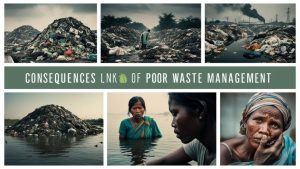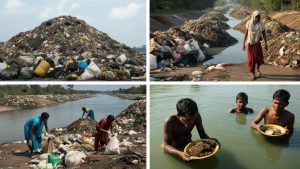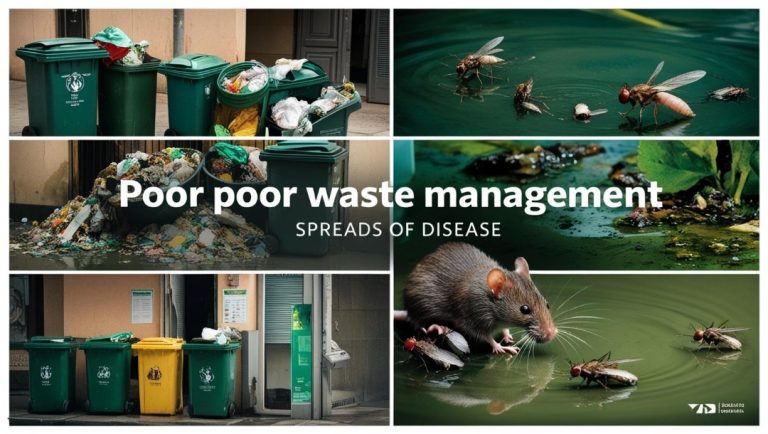Poor waste management in livestock and poultry farming poses significant health risks to animals, farmworkers, and surrounding communities. Accumulated waste, including manure, urine, bedding materials, and feed residues, can become breeding grounds for harmful pathogens, leading to various infectious diseases. These diseases not only affect animal productivity but can also be transmitted to humans, causing public health concerns. Proper waste disposal, composting, and biosecurity measures are essential to prevent disease outbreaks. This article explores the diseases associated with inadequate waste management and the strategies for mitigating these risks.
Bacterial Diseases
Click HERE to join our WhatsApp group chat
a) Salmonellosis
Cause: Salmonella bacteria thrive in fecal-contaminated environments.
Transmission: Ingesting contaminated water, feed, or direct contact with infected waste.
Symptoms in Animals: Diarrhea, fever, weight loss, and lethargy.
Symptoms in Humans: Food poisoning, nausea, vomiting, and severe diarrhea.
Prevention: Proper manure disposal, clean drinking water, and biosecurity measures.
b) Leptospirosis
Cause: Leptospira bacteria found in urine-contaminated soil and water.
Transmission: Direct contact with infected urine, contaminated water, or through cuts and mucous membranes.
Symptoms in Animals: Fever, jaundice, kidney damage, and reproductive issues.
Symptoms in Humans: Flu-like symptoms, liver damage, and meningitis.
Prevention: Waste management, vaccination, and rodent control.
c) Escherichia coli (E. coli) Infection
Cause: E. coli bacteria found in fecal matter and contaminated feed.
Transmission: Ingesting contaminated food or water.
Symptoms in Animals: Severe diarrhea, dehydration, and growth retardation.
Symptoms in Humans: Abdominal cramps, diarrhea, kidney failure (severe cases).
Prevention: Proper manure handling and hygienic feeding practices.
READ ALSO: Emerging Livestock Diseases and Their Threats
Viral Diseases

a) Foot-and-Mouth Disease (FMD)
Cause: A highly contagious virus affecting cloven-hoofed animals.
Transmission: Contaminated soil, manure, and animal secretions.
Symptoms in Animals: Blisters on mouth, hooves, excessive salivation, and lameness.
Impact: Economic losses due to trade restrictions and reduced livestock productivity.
Prevention: Proper disposal of infected waste, quarantine measures, and vaccination.
b) Newcastle Disease
Cause: A virus affecting poultry, thriving in contaminated feces and bedding.
Transmission: Airborne particles, contaminated feed, and direct contact with infected waste.
Symptoms in Poultry: Respiratory distress, paralysis, greenish diarrhea, and sudden death.
Prevention: Regular waste removal, disinfection, and vaccination.
c) Rotavirus Infection
Cause: A virus common in young animals, spreading through fecal contamination.
Transmission: Ingesting contaminated feed or water.
Symptoms in Animals: Severe diarrhea, dehydration, and stunted growth.
Symptoms in Humans: Gastroenteritis, vomiting, and fever.
Prevention: Proper waste disposal and hygiene.
Parasitic Diseases

a) Coccidiosis
Cause: Parasitic protozoa (Eimeria species) thriving in contaminated bedding and manure.
Transmission: Ingesting fecal-contaminated food or water.
Symptoms in Animals: Diarrhea (sometimes bloody), weight loss, and poor growth.
Prevention: Regular cleaning, proper waste disposal, and anticoccidial medications.
READ ALSO: Smart Farming Technologies in Livestock Production
b) Cryptosporidiosis
Cause: Cryptosporidium parasites found in fecal-contaminated water.
Transmission: Direct or indirect ingestion of contaminated materials.
Symptoms in Animals: Diarrhea, dehydration, and reduced feed efficiency.
Symptoms in Humans: Severe diarrhea, abdominal cramps, and dehydration.
Prevention: Proper manure treatment, clean water sources, and biosecurity measures.
c) Helminth Infections (Worms)
Cause: Parasitic worms (roundworms, tapeworms) developing in waste-contaminated pastures.
Transmission: Ingesting contaminated grass, feed, or water.
Symptoms in Animals: Poor growth, anemia, and gastrointestinal distress.
Prevention: Regular deworming, proper waste disposal, and rotational grazing.
Fungal Diseases
a) Aspergillosis
Cause: Aspergillus fungi thriving in damp, decomposing organic waste.
Transmission: Inhalation of fungal spores.
Symptoms in Poultry and Livestock: Respiratory distress, weight loss, and reduced egg production.
Symptoms in Humans: Allergic reactions, lung infections, and flu-like symptoms.
Prevention: Proper drying of manure and feed, and adequate ventilation.
b) Mycotoxicosis
Cause: Toxins produced by fungi growing in contaminated feed and waste.
Transmission: Consumption of mold-contaminated feed.
Symptoms in Animals: Liver damage, immune suppression, poor growth, and reproductive failure.
Prevention: Proper feed storage, mold prevention, and mycotoxin binders.
READ ALSO: Alternative Feed Resources for Cost Reduction
Zoonotic Diseases (Transmissible to Humans)

a) Brucellosis
Cause: Brucella bacteria found in animal waste and reproductive fluids.
Transmission: Contact with contaminated manure, aborted fetuses, or unpasteurized dairy products.
Symptoms in Humans: Fever, joint pain, fatigue, and reproductive issues.
Prevention: Proper disposal of animal waste, vaccination, and personal protective equipment (PPE).
b) Anthrax
Cause: Bacillus anthracis bacteria found in contaminated soil and waste.
Transmission: Inhalation or ingestion of spores in waste-contaminated areas.
Symptoms in Animals: Sudden death, fever, and bleeding from body openings.
Symptoms in Humans: Skin ulcers, respiratory distress, and septicemia.
Prevention: Proper carcass disposal, vaccination, and waste treatment.
Waste Management Strategies to Prevent Disease
a) Proper Manure Storage and Composting
Composting kills harmful pathogens and reduces odor.
Well-managed manure pits prevent contamination of water sources.
b) Regular Cleaning and Disinfection
Clean livestock housing and equipment regularly.
Use disinfectants to eliminate disease-causing microbes.
c) Safe Water Management
Prevent waste runoff into water bodies.
Provide clean, uncontaminated drinking water to animals.
d) Biosecurity Measures
Control movement of animals and people to prevent disease spread.
Implement quarantine measures for sick animals.
e) Proper Waste Disposal Systems
Use designated areas for waste treatment and disposal.
Avoid dumping animal waste in open fields or water sources.
Conclusion
Poor waste management in livestock and poultry farming creates an environment conducive to disease outbreaks, posing risks to both animal and human health. Proper waste disposal, sanitation, and biosecurity measures can mitigate these risks, ensuring healthier livestock and safer food production. By adopting sustainable waste management practices, farmers can reduce disease prevalence, improve productivity, and contribute to environmental conservation.
READ ALSO: Nutritional Requirements for Quails
Quail farming has gained popularity due to its economic benefits, low space requirements, and fast production cycle. To maximize productivity, it is crucial to understand and meet the nutritional requirements of quails at different growth stages. Proper nutrition ensures high egg production, rapid growth, good health, and disease resistance…
READ ALSO: Growth Promoters and Their Effects in Animal Nutrition
Growth promoters are substances added to animal feed to enhance growth rates, improve feed efficiency, and boost overall animal health. They play a crucial role in modern animal nutrition, particularly in intensive livestock production, where efficiency and profitability are key concerns. Growth promoters can include antibiotics, probiotics, prebiotics, hormones, enzymes, and plant-based additives. While they offer numerous benefits, their use has also sparked debates regarding safety, sustainability, and regulatory concerns…
Click HERE to join our WhatsApp group chat

